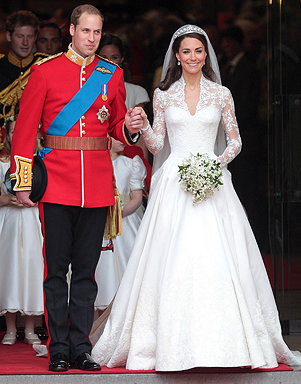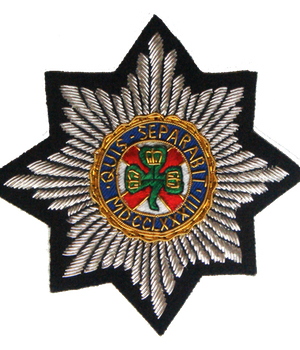Much of the anticipation and planning related to a wedding is usually concerned with the bride and her dress. Usually, this leads to the bride (quite rightly) being regarded as the focal point of a marriage ceremony, with her dress representing not only the fulfillment of her childhood dreams, but also serving as a tangible and lasting reminder of the special day. In contrast, many grooms are less concerned with their wedding day attire, and normally opt for a conventional suit or tuxedo. Some choose to wed in traditional dress (for example grooms of Scottish ancestry) or military uniform, if they are serving members in the armed forces.
The most notable wedding of the last several years is, without a doubt, that of Prince William, Duke of Cambridge, and Catherine Middleton – or Will and Kate, as they are sit-comically known. Since I do not profess to be an expert on wedding gowns, this post will spend some time looking at the uniform William wore on his wedding day.
The scarlet tunic has been a conspicuous trademark of the British infantry since the middle of the 17th century. It appears as if the now famous choice of red was inspired more by economy than valour, since the pigment used to achieve the distinctive shade of red dye was relatively easily sourced from the madder plant (rubia tinctorum) before the advent of synthetic textile dyes. The “red coat” (a term that became synonymous with the British infantryman) was officially replaced by the more practical and demure khaki drill uniform in 1902, which saw service in the South African (Boer) War between 1899 and 1902. Khaki was better suited to the climate and geography of many British colonies and offered better camouflage properties. The latter is itself representative of the evolution of infantry weaponry, since accurate, breech-loading rifled firearms and smokeless ammunition made individuals easier to target in combat. Previously, infantry were grouped in mass formations in the field of battle for the purpose of discharging volleys of musket fire at the enemy – a strategy that favours numbers over accuracy (and also produced vast clouds of black powder smoke). Nevertheless, the red tunic was retained for formal and ceremonial occasions, hence its use during the royal wedding. William’s particular choice of uniform was that of an officer in the Irish Guards regiment.
Rank, insignia and decorations
It was generally expected that William would have chosen to marry in the ceremonial uniform of the Royal Air Force, since he is currently serving as a Flight Lieutenant in the RAF Search and Rescue Force. In fact, William could have elected to don the uniform of either of the three branches of the British armed forces, by virtue of his enrollment and commission in the Army, Navy and RAF. However, between the services his highest rank is that of Colonel in the Irish Guards – a ceremonial appointment granted to him by his grandmother, the Queen in 2011. As explained in a previous post, the rank of colonel in the British Army is represented by two stars and a crown, which William wears on his shoulder epaulettes. The uniform’s affiliation to the Irish Guards is readily visible by the embroidered shamrock on either side of the tunic collar, as well as the arrangement of the buttons in two rows of four, reflecting the regiment’s position as the fourth most senior Guards regiment. The regimental badge of the Irish Guards also reflects the regiment’s origins in the form of a St. Patrick’s cross (the patron saint of Ireland) and a shamrock. The regiment’s motto is Quis Separabit?, which translates to “who shall separate us?” (a coincidental and appropriate sentiment on the occasion of a wedding).
The red sash worn around the waist is made of silk and was traditionally worn by officers and NCO’s as means of distinguishing them to their troops in the field of battle. The blue sash worn over the shoulder is part of the insignia of the Most Noble Order of the Garter, as is the star worn on the lower left breast of the tunic. The Order of the Garter is the highest order of chivalry and the most prestigious honour of the United Kingdom. Membership to the order (members are referred to as Knights or Ladies companion) is conferred exclusively by the monarch as a personal gift and the order may have no more than 24 members at any given time, excluding members of the royal family. On the sash, nearer the shoulder, William wears the wings of the RAF as a reference to his current service as a pilot. The single medal pinned to the Garter Sash is the Queen Elizabeth II Golden Jubilee Medal that was awarded in 2002 to commemorate the fiftieth anniversary of the Elizabeth’s accession to the throne. Subsequent to the wedding, in 2012, he was awarded the Diamond Jubilee Medal in the sixtieth year of Elizabeth’s reign.
Cap, trousers and boots
The conventional ceremonial headgear of the Irish Guards is the well-known bearskin hat that is word by all five the Regiments of the Foot Guards. Perhaps for reasons of practicality, William opted for the regiment’s alternate black officer’s cap. The cap features gold embroidery on the visor, signifying officer rank. The traditional black trousers feature the traditional red stripe, echoing the scarlet tunic. On the occasion of his wedding, William also chose to wear spurs on his boots. These spurs are also conferred by the monarch to male recipients as part of the insignia of the Order of the Garter, and alludes to the previously mentioned fact that they are styled as Knights Companion.
Thus, this royal groom’s attire, perhaps more so than that of the bride, deserves closer scrutiny – its provenance is most certainly richer and more interesting than that his better half!

